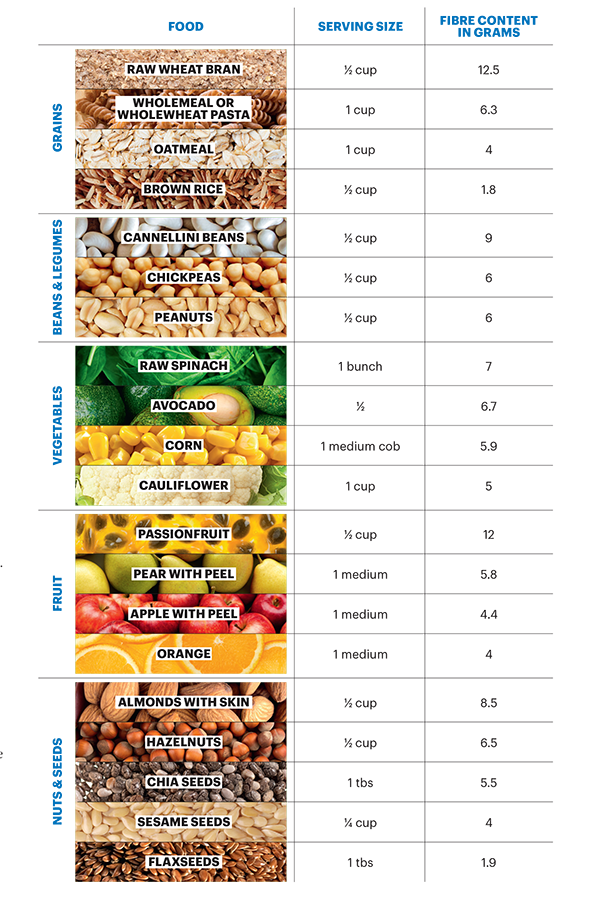When it comes to maintaining a healthy diet, including foods that are high in soluble fiber can be incredibly beneficial. Soluble fiber is a type of fiber that dissolves in water and forms a gel-like substance in the digestive tract. This gel can help to slow down digestion, promote feelings of fullness, and regulate blood sugar levels. It can also aid in lowering cholesterol levels and improving heart health. Incorporating soluble fiber-rich foods into your meals can be a delicious and easy way to support overall wellness.
High Fiber Foods Chart
 One great resource for identifying high fiber foods is a printable chart that provides a comprehensive list. This chart includes a variety of options such as fruits, vegetables, whole grains, and legumes. Some examples of high soluble fiber foods include:
One great resource for identifying high fiber foods is a printable chart that provides a comprehensive list. This chart includes a variety of options such as fruits, vegetables, whole grains, and legumes. Some examples of high soluble fiber foods include:
- Oats and oat bran
- Legumes such as black beans, chickpeas, and lentils
- Fruits like apples, oranges, and berries
- Vegetables such as Brussels sprouts, broccoli, and carrots
- Whole grains like barley, quinoa, and brown rice
- Seeds and nuts including flaxseeds, chia seeds, and almonds
- Psyllium husk and flaxmeal
Exploring the Benefits of Soluble Fiber
 Now that we have a better understanding of the wide range of high soluble fiber foods available, let’s explore the numerous benefits that come with incorporating them into our diet:
Now that we have a better understanding of the wide range of high soluble fiber foods available, let’s explore the numerous benefits that come with incorporating them into our diet:
Improved Digestive Health:
Soluble fiber acts as a prebiotic, providing nourishment for the beneficial bacteria in our gut. This helps to maintain a healthy balance of gut flora and supports optimal digestion.
Heart Health:
Evidence suggests that a diet rich in soluble fiber can help lower LDL cholesterol levels, also known as “bad” cholesterol. By reducing cholesterol absorption in the bloodstream, soluble fiber helps to protect against cardiovascular diseases.

Consuming soluble fiber slows down the absorption of glucose, helping to prevent blood sugar spikes after meals. This is particularly important for individuals with diabetes or anyone looking to maintain stable blood sugar levels.
Weight Management:
Foods high in soluble fiber can make you feel fuller for longer, reducing the likelihood of overeating. Additionally, the slow digestion process associated with soluble fiber may increase calorie burning.
Supporting Gut Health:
Soluble fiber adds bulk to the stool, aiding regular bowel movements and preventing constipation. It can also help relieve symptoms of Irritable Bowel Syndrome (IBS) by promoting healthy bowel function.
Reducing Inflammation:
Studies have shown that consuming high soluble fiber foods can help reduce chronic inflammation in the body. Inflammation is associated with various health conditions, including heart disease, diabetes, and certain types of cancer.
How to Incorporate Soluble Fiber-Rich Foods:
Now that we understand the benefits, it’s essential to know how to incorporate soluble fiber-rich foods into our daily meals. Here are a few simple ideas:
Start Your Day with Oatmeal:
Swap your usual breakfast cereal or toast for a comforting bowl of oatmeal. Top it off with berries, a sprinkle of flaxseed, or a spoonful of nut butter for added soluble fiber.
Add Legumes to Soups and Salads:
Whether you’re making a hearty soup or a refreshing salad, including legumes like lentils, chickpeas, or black beans can provide an excellent source of soluble fiber and protein.
 #### Choose Whole Grains:
#### Choose Whole Grains:
Instead of refined grains, opt for whole grains like quinoa, brown rice, and whole wheat bread. These options not only contain soluble fiber but also provide valuable nutrients.
Snack on Fruits and Vegetables:
Keep a bowl of fresh fruits like apples and oranges on your kitchen counter for a quick and nutritious snack. Incorporate fiber-rich vegetables into meals or enjoy them as crunchy and satisfying snacks.
Experiment with Chia Seeds and Flaxseeds:
These tiny seeds are packed with soluble fiber and can be sprinkled over yogurt, added to smoothies, or used in baking recipes for an extra nutritional boost.
By incorporating these simple tips into your daily meal plan, you can easily increase your soluble fiber intake and enjoy the numerous health benefits associated with it. Remember to consult with your healthcare provider or a registered dietitian before making significant changes to your diet.
So, let’s start embracing high soluble fiber foods and take a step towards improving our overall health and well-being!